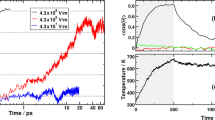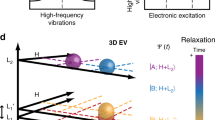Abstract
The catalytic power of an electric field depends on its magnitude and orientation with respect to the reactive chemical species. Understanding and designing new catalysts for electrostatic catalysis thus requires methods to measure the electric field orientation and magnitude at the molecular scale. We demonstrate that electric field orientations can be extracted using a two-directional vibrational probe by exploiting the vibrational Stark effect of both the C=O and C–D stretches of a deuterated aldehyde. Combining spectroscopy with molecular dynamics and electronic structure partitioning methods, we demonstrate that, despite distinct polarities, solvents act similarly in their preference for electrostatically stabilizing large bond dipoles at the expense of destabilizing small ones. In contrast, we find that for an active-site aldehyde inhibitor of liver alcohol dehydrogenase, the electric field orientation deviates markedly from that found in solvents, which provides direct evidence for the fundamental difference between the electrostatic environment of solvents and that of a preorganized enzyme active site.

This is a preview of subscription content, access via your institution
Access options
Access Nature and 54 other Nature Portfolio journals
Get Nature+, our best-value online-access subscription
$29.99 / 30 days
cancel any time
Subscribe to this journal
Receive 12 print issues and online access
$259.00 per year
only $21.58 per issue
Buy this article
- Purchase on Springer Link
- Instant access to full article PDF
Prices may be subject to local taxes which are calculated during checkout





Similar content being viewed by others
Data availability
The gene sequence for the wild-type enzyme in this study has been deposited in GenBank (accession code OM863576). The X-ray coordinates and structural factors have been deposited in the Protein Data Bank as entry 7RM6 for the wild-type enzyme in complex with NADH and CXF. The electronic structure partitioning methods for DFT calculations of solvent electric fields at atomic positions were implemented in the Q-Chem software package36, which is available in the 5.4.2 and later releases. Source data are provided with this paper. All the data that support the finding of this study are available within this article and its Supplementary Information and available on Figshare (https://doi.org/10.6084/m9.figshare.19248108).
Code availability
The code used for processing MD trajectories and calculating electric field projections along bond directions is available at https://github.com/YuezhiMao/2D_VSE_probe and Zenodo (https://zenodo.org/record/6300009#.Yhw0GBPMKS4)
References
Warshel, A. et al. Electrostatic basis for enzyme catalysis. Chem. Rev. 106, 3210–3235 (2006).
Fried, S. D. & Boxer, S. G. Electric fields and enzyme catalysis. Annu. Rev. Biochem. 86, 387–415 (2017).
Schneider, S. H. & Boxer, S. G. Vibrational Stark effects of carbonyl probes applied to reinterpret IR and Raman data for enzyme inhibitors in terms of electric fields at the active site. J. Phys. Chem. B 120, 9672–9684 (2016).
Carey, P. R. Spectroscopic characterization of distortion in enzyme complexes. Chem. Rev. 106, 3043–3054 (2006).
Dong, J. et al. The strength of dehalogenase–substrate hydrogen bonding correlates with the rate of Meisenheimer intermediate formation. Biochemistry 42, 9482–9490 (2003).
Tonge, P. J. & Carey, P. R. Length of the acyl carbonyl bond in acyl-serine proteases correlates with reactivity. Biochemistry 29, 10723–10727 (1990).
Deng, H. et al. Source of catalysis in the lactate dehydrogenase system. Ground-state interactions in the enzyme-substrate complex. Biochemistry 33, 2297–2305 (1994).
Fried, S. D., Bagchi, S. & Boxer, S. G. Extreme electric fields power catalysis in the active site of ketosteroid isomerase. Science 346, 1510–1514 (2014).
Wu, Y. & Boxer, S. G. A critical test of the electrostatic contribution to catalysis with noncanonical amino acids in ketosteroid isomerase. J. Am. Chem. Soc. 138, 11890–11895 (2016).
Fried, S. D. & Boxer, S. G. Measuring electric fields and noncovalent interactions using the vibrational stark effect. Acc. Chem. Res. 48, 998–1006 (2015).
Fried, S. D., Bagchi, S. & Boxer, S. G. Measuring electrostatic fields in both hydrogen-bonding and non-hydrogen-bonding environments using carbonyl vibrational probes. J. Am. Chem. Soc. 135, 11181–11192 (2013).
Wu, Y., Fried, S. D. & Boxer, S. G. A preorganized electric field leads to minimal geometrical reorientation in the catalytic reaction of ketosteroid isomerase. J. Am. Chem. Soc. 142, 9993–9998 (2020).
Welborn, V. V. & Head-Gordon, T. Computational design of synthetic enzymes. Chem. Rev. 119, 6613–6630 (2019).
Welborn, V. V., Pestana, L. R. & Head-Gordon, T. Computational optimization of electric fields for better catalysis design. Nat. Catal. 1, 649–655 (2018).
Fuxreiter, M. & Mones, L. The role of reorganization energy in rational enzyme design. Curr. Opin. Chem. Biol. 21, 34–41 (2014).
Kamerlin, S. C., Sharma, P. K., Chu, Z. T. & Warshel, A. Ketosteroid isomerase provides further support for the idea that enzymes work by electrostatic preorganization. Proc. Natl Acad. Sci. USA 107, 4075–4080 (2010).
Bím, D. & Alexandrova, A. N. Electrostatic regulation of blue copper sites. Chem. Sci. 12, 11406–11413 (2021).
Shaik, S., Mandal, D. & Ramanan, R. Oriented electric fields as future smart reagents in chemistry. Nat. Chem. 8, 1091–1098 (2016).
Xu, L., Izgorodina, E. I. & Coote, M. L. Ordered solvents and ionic liquids can be harnessed for electrostatic catalysis. J. Am. Chem. Soc. 142, 12826–12833 (2020).
Deng, H., Schindler, J. F., Berst, K. B., Plapp, B. V. & Callender, R. A Raman spectroscopic characterization of bonding in the complex of horse liver alcohol dehydrogenase with NADH and N-cyclohexylformamide. Biochemistry 37, 14267–14278 (1998).
Ramaswamy, S., Scholze, M. & Plapp, B. V. Binding of formamides to liver alcohol dehydrogenase. Biochemistry 36, 3522–3527 (1997).
Claudino, D. & Mayhall, N. J. Automatic partition of orbital spaces based on singular value decomposition in the context of embedding theories. J. Chem. Theory Comput. 15, 1053–1064 (2019).
Khaliullin, R. Z., Head-Gordon, M. & Bell, A. T. An efficient self-consistent field method for large systems of weakly interacting components. J. Chem. Phys. 124, 204105 (2006).
Adhikary, R., Zimmermann, J. & Romesberg, F. E. Transparent window vibrational probes for the characterization of proteins with high structural and temporal resolution. Chem. Rev. 117, 1927–1969 (2017).
Bublitz, G. U. & Boxer, S. G. Stark spectroscopy: applications in chemistry, biology, and materials science. Annu. Rev. Phys. Chem. 48, 213–242 (1997).
Boxer, S. G. Stark realities. J. Phys. Chem. B 113, 2972–2983 (2009).
Baiz, C. R. et al. Vibrational spectroscopic map, vibrational spectroscopy, and intermolecular interaction. Chem. Rev. 120, 7152–7218 (2020).
Kozuch, J. et al. Testing the limitations of MD-based local electric fields using the vibrational Stark effect in solution: penicillin G as a test case. J. Phys. Chem. B 125, 4415–4427 (2021).
Fried, S. D., Wang, L. P., Boxer, S. G., Ren, P. & Pande, V. S. Calculations of the electric fields in liquid solutions. J. Phys. Chem. B 117, 16236–16248 (2013).
Eggers, D. F. & Lingren, W. E. C–H vibrations in aldehydes. Anal. Chem. 28, 1328–1329 (1956).
Onsager, L. Electric moments of molecules in liquids. J. Am. Chem. Soc. 58, 1486–1493 (1936).
Levinson, N. M., Fried, S. D. & Boxer, S. G. Solvent-induced infrared frequency shifts in aromatic nitriles are quantitatively described by the vibrational Stark effect. J. Phys. Chem. B 116, 10470–10476 (2012).
Tomasi, J., Mennucci, B. & Cammi, R. Quantum mechanical continuum solvation models. Chem. Rev. 105, 2999–3093 (2005).
Sekhar, V. C. & Plapp, B. V. Rate constants for a mechanism including intermediates in the interconversion of ternary complexes by horse liver alcohol dehydrogenase. Biochemistry 29, 4289–4295 (1990).
Reichardt, C. & Welton, T. Solvents and Solvent Effects in Organic Chemistry (John Wiley & Sons, 2011).
Epifanovsky, E. et al. Software for the frontiers of quantum chemistry: an overview of developments in the Q-Chem 5 package. J. Chem. Phys. 155, 084801 (2021).
Johnson, R. D. III NIST Computational Chemistry Comparison and Benchmark Database. NIST Standard Reference Database Number 101, Release 21 August 2020 (NIST, accessed 2 January 2021).
Acknowledgements
We express our gratitude to B. V. Plapp at the University of Iowa for providing detailed guidance on the expression and purification of LADH and much other valuable advice. We thank C.-Y. Lin for his help with X-ray crystallography, S. Schneider, J. Weaver, J. Kirsh and S. D. E. Fried for helpful discussions, T. Carver at the Stanford Nano Shared Facilities for nickel coating the Stark windows, T. McLaughlin from Stanford University Mass Spectrometry (SUMS) for technical support with the mass spectrometry. C.Z. is grateful for the Stanford Center for Molecular Analysis and Design (CMAD) Fellowship. J.K. acknowledges support from the German Research Foundation DFG-Project-ID221545957-SFB1078/B9. This work was supported in part by NIH Grant GM118044 (to S.G.B.) and the National Science Foundation grant no. CHE-1652960 (to T.E.M.). T.E.M. also acknowledges support from the Camille Dreyfus Teacher-Scholar Awards Program. Use of the Stanford Synchrotron Radiation Lightsource, SLAC National Accelerator Laboratory, is supported by the US Department of Energy, Office of Science, Office of Basic Energy Sciences under contract no. DE-AC02-76SF00515. The SSRL Structural Molecular Biology Program is supported by the DOE Office of Biological and Environmental Research, and by the National Institutes of Health, National Institute of General Medical Sciences (P30GM133894). The contents of this publication are solely the responsibility of the authors and do not necessarily represent the official views of NIGMS or NIH. This research also used resources of the National Energy Research Scientific Computing Center (NERSC), a US Department of Energy Office of Science User Facility operated under contract no. DE-AC02-05CH11231, and the Sherlock cluster operated by the Stanford Research Computing Center.
Author information
Authors and Affiliations
Contributions
C.Z. and S.G.B. designed the research. C.Z. performed the experiments and fixed-charge MD simulations. Y.M. developed the computational protocol that combined MD simulations and QM calculations to quantify the solvent electric field contributions, implemented the electronic structure partitioning schemes in the Q-Chem software package and performed the QM calculations. J.K. performed the AMOEBA polarizable MD simulations. A.O.A. analysed the data from the MD simulations and wrote the codes to extract the truncated solute–solvent structures for the QM calculations. Z.J. synthesized N-[formyl-2H]cyclohexylformamide. C.Z., Y.M., T.E.M. and S.G.B. discussed the results and wrote the manuscript. All the authors contributed to improving the manuscript.
Corresponding authors
Ethics declarations
Competing interests
The authors declare no competing interests.
Peer review
Peer review information
Nature Chemistry thanks Steven Corcelli, Jahan Dawlaty, Feng Gai, Valerie Welborn for their contribution to the peer review of this work.
Additional information
Publisher’s note Springer Nature remains neutral with regard to jurisdictional claims in published maps and institutional affiliations.
Supplementary information
Supplementary Information
Materials and Methods, Supplementary Texts, Figures 1–17 and Tables 1–31.
Source data
Source Data Fig. 2
Numerical data for optical spectra.
Source Data Fig. 3
Numerical data for optical spectra.
Source Data Fig. 4
Numerical data for scatter plots.
Source Data Fig. 5
Numerical data for optical spectra and scatter plots.
Rights and permissions
About this article
Cite this article
Zheng, C., Mao, Y., Kozuch, J. et al. A two-directional vibrational probe reveals different electric field orientations in solution and an enzyme active site. Nat. Chem. 14, 891–897 (2022). https://doi.org/10.1038/s41557-022-00937-w
Received:
Accepted:
Published:
Issue Date:
DOI: https://doi.org/10.1038/s41557-022-00937-w



